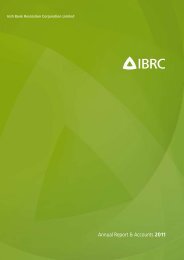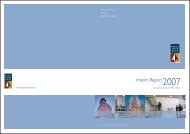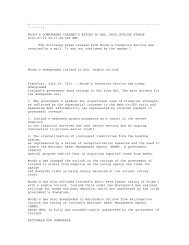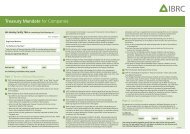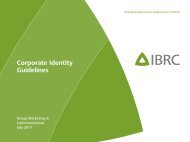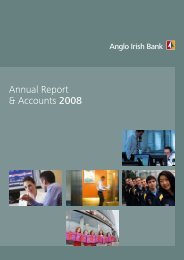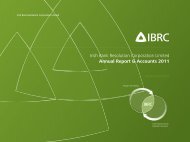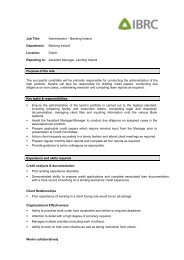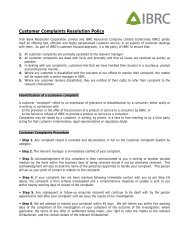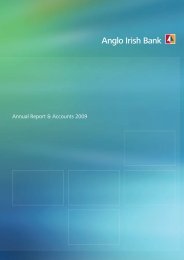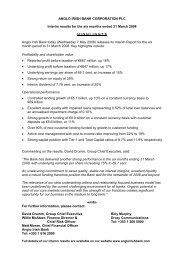summary rating rationale - Irish Bank Resolution Corporation ...
summary rating rationale - Irish Bank Resolution Corporation ...
summary rating rationale - Irish Bank Resolution Corporation ...
Create successful ePaper yourself
Turn your PDF publications into a flip-book with our unique Google optimized e-Paper software.
incorporate those aspects of credit risk relevant to the prospective payment performance of rated banks with respect to deposit obligations,which includes: intrinsic financial strength, sovereign transfer risk (in the case of foreign currency deposit <strong>rating</strong>s), and both implicit and explicitexternal support elements. Moody's <strong>Bank</strong> Deposit Ratings do not take into account the benefit of deposit insurance schemes which makepayments to depositors, but they do recognize the potential support from schemes that may provide assistance to banks directly.According to Moody's joint default analysis (JDA) methodology, the global local currency deposit <strong>rating</strong> of a bank is determined by theincorporation of external elements of support into the bank's Baseline Risk Assessment. In calculating the Global Local Currency Deposit <strong>rating</strong>for a bank, the JDA methodology also factors in the <strong>rating</strong> of the support provider, in the form of the local currency deposit ceiling for a country,Moody's assessment of the probability of systemic support for the bank in the event of a stress situation and the degree of dependencebetween the issuer <strong>rating</strong> and the Local Currency Deposit Ceiling.National Scale RatingNational scale <strong>rating</strong>s are intended primarily for use by domestic investors and are not comparable to Moody's globally applicable <strong>rating</strong>s; ratherthey address relative credit risk within a given country. A Aaa <strong>rating</strong> on Moody's National Scale indicates an issuer or issue with the strongestcreditworthiness and the lowest likelihood of credit loss relative to other domestic issuers. National Scale Ratings, therefore, rank domesticissuers relative to each other and not relative to absolute default risks. National <strong>rating</strong>s isolate systemic risks; they do not address lossexpectation associated with systemic events that could affect all issuers, even those that receive the highest <strong>rating</strong>s on the National Scale.Foreign Currency Deposit RatingForeign currency debt <strong>rating</strong>s are derived from the bank's local currency debt <strong>rating</strong>. In a similar way to foreign currency deposit <strong>rating</strong>s, foreigncurrency debt <strong>rating</strong>s may also be constrained by the country ceiling for foreign currency bonds and notes; however, in some cases the <strong>rating</strong>son foreign currency debt obligations may be allowed to pierce the foreign currency ceiling. A particular mix of <strong>rating</strong> factors are taken intoconsideration in order to assess whether a foreign currency bond <strong>rating</strong> pierces the country ceiling. They include the issuer's global localcurrency <strong>rating</strong>, the foreign currency government bond <strong>rating</strong>, the country ceiling for bonds and the debt's eligibility to pierce that ceiling.About Moody's <strong>Bank</strong> Financial Strength ScorecardMoody's bank financial strength model (see scorecard below) is a strategic input in the assessment of the financial strength of a bank, used asa key tool by Moody's analysts to ensure consistency of approach across banks and regions. The model output and the individual scores arediscussed in <strong>rating</strong> committees and may be adjusted up or down to reflect conditions specific to each rated entity.Rating FactorsAnglo <strong>Irish</strong> <strong>Bank</strong> <strong>Corporation</strong> LimitedRating Factors [1] A B C D E Total Score TrendQualitative Factors (50%) D-Factor: Franchise Value E+ WeakeningMarket Share and Sustainability xGeographical Diversification xEarnings Stability xEarnings Diversification [2] xFactor: Risk Positioning E WeakeningCorporate Governance [2]- Ownership and Organizational Complexity- Key Man Risk- Insider and Related-Party RisksControls and Risk Management x- Risk Management x- Controls xFinancial Reporting Transparency x- Global Comparability x- Frequency and Timeliness x- Quality of Financial Information xCredit Risk Concentration x- Borrower Concentration x- Industry Concentration xLiquidity Management xMarket Risk Appetite xFactor: Ope<strong>rating</strong> Environment B WeakeningEconomic Stability xIntegrity and Corruption xLegal System xFinancial Factors (50%) DFactor: Profitability E+ Weakening



